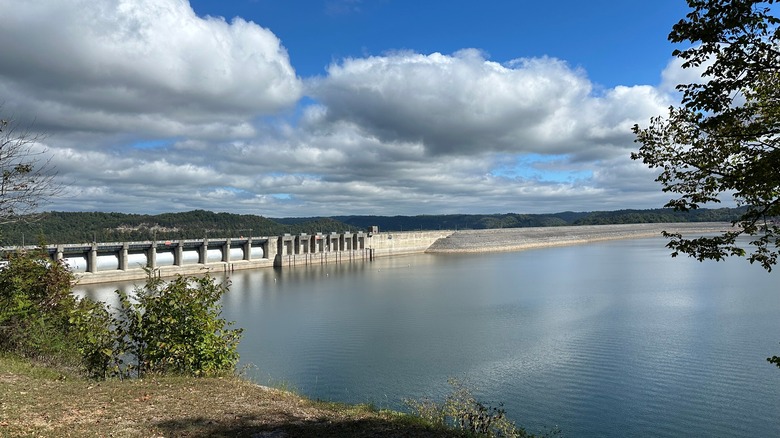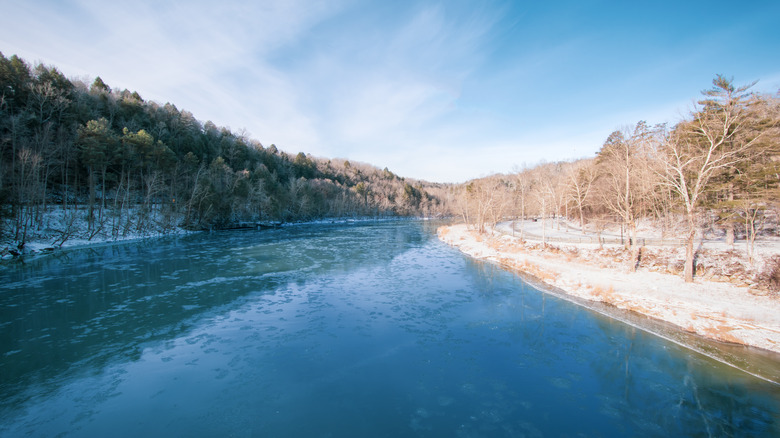A Winding Kentucky River Below The Dam Lures Anglers With Misty Mornings And Record Rainbow Trout
An unlikely trophy fishery in the heart of bass and panfish country in southern Kentucky keeps anglers busy all year long, thanks to miles of water abundantly stocked with trout. The Cumberland River near Jamestown, Kentucky, flows clear and cold from the bottom of Lake Cumberland through the outflow at Wolf Creek Dam. Since both brown and rainbow trout are coldwater fish, the tailwater river below the dam is a legitimate trout river. Depending on the time of year, the fishery can stretch some 75 miles downstream (and even more as the river flows into Tennessee). According to the Kentucky Department of Fish & Wildlife Resources, the biggest rainbow trout caught on the Cumberland below Wolf Creek Dam was a 14.38-pound behemoth that came to hand in 1972. The river's biggest brown trout? A massive 21-pounder caught by one Thomas Malone in April 2000.
Wolf Creek Dam on the Cumberland River is in a remote reach of southern Kentucky — a full two-and-a-half-hour drive from Nashville and its international airport and about 44 miles from Somerset, a "jumping off" point for vibrant arts and Lake Cumberland adventure. The dam is the 22nd-largest in the United States and was constructed in 1952. The dam backs up Lake Cumberland, which stretches 101 miles long and boasts 63,000 surface acres and 1,255 miles of wooded shoreline. Lake Cumberland is a well-known warm-water fishery for bass, panfish, catfish, and more. The Cumberland River below the dam is ideal for trout anglers, particularly when the turbines aren't busy producing hydroelectricity. Fly fishers looking for trout should familiarize themselves with the dam's generation schedule.
A coldwater paradise for fly fishers in the Southeast
The Cumberland River below Wolf Creek Dam is among the best trout rivers in the Southeast, rivaling similar fisheries like the White River in Arkansas and the Chattahoochee River in Georgia (home to the world's longest urban whitewater course). Fly fishers chasing rainbow trout and brown trout on the Cumberland should almost always start with nymph patterns, but the fish aren't terribly picky. Per Rivers and Feathers, nymphing anglers report success with flies like the prince nymph, the bead head pheasant tail, and the copper John.
That's not to say the river's trout won't rise to dry flies or chase bigger streamers — the Cumberland's burly brown trout eat bigger bugs and other fish. They'll chase sculpin and articulated streamer patterns, like Matukas. During hatches and warm weather when terrestrial bugs are present around the river, anglers might consider casting ant or beetle imitations to get fish to come to the top.
Wolf Creek Dam's generation schedule favors a winter trout season below the dam. For anglers visiting the Cumberland for the first time, it's a good idea to hire a guide through a local outfitter. One day with a guide can significantly shorten the learning curve, making it easier to find fish and fishing locations on the river during subsequent visits. A good option is the Cumberland Trout Guide based in Jamestown. Here, anglers can hire a guide and a drift boat to learn the ropes of fishing this trout-filled section of the Cumberland before trying it on their own. Guides usually launch boats during the misty morning hours before water is pushed through the generation turbines.
Other angling opportunities near Jamestown
While trout are likely the most sought-after fish in the Cumberland River below Wolf Creek Dam, there are other worthy fish in the area. According to the Kentucky Department of Fish and Wildlife, the Cumberland River tailwater below Wolf Creek Dam is also home to walleye, sauger, and some huge striped bass. Because the river stays cool all year long and is home to plenty of forage fish, the striped bass fishing is excellent. Anglers looking for big bass should stick with soft-plastic swimbaits or, for fly fishers, weighted streamers. Striped bass up to 30 pounds regularly come from the tailwater reaches of the Cumberland.
The river's walleye are fat and healthy fish, likely for the same reason the Cumberland's bass get so big — there's lots to eat. The river's walleye tend to stack up below Wolf Creek Dam in the winter months. This is when the waters of the Cumberland Lake above the dam start to cool off, and bait fish like shad and alewives become stressed by the cold water. When this happens, they get sucked through the dam's turbines and create a downstream buffet for the river's walleyes (and likely its big trout, too). Regardless of the fish anglers chase on the Cumberland River below Wolf Creek Dam, they will have lots of options. And they don't have to just fish for trout. Along the Kentucky-Tennessee border, just over 30 miles from Wolf Creek Dam, is the renowned Dale Hollow Lake, an unbelievably clear lake with some of the South's best fishing. In this fishy corner of Kentucky, anything is possible.


